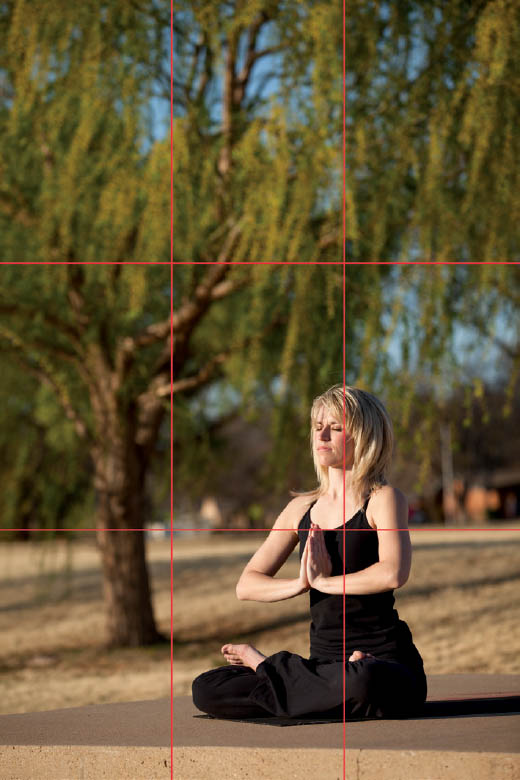23. RULES ARE RULES
![]()
THE CONCEPTS OF composition have been passed down for centuries through art, architecture, and just about anything else that has visually captivated society—there are certainly a few thoughts about what works and what doesn’t. Photography has been heavily influenced by these rules because they often pave the path to successful images.
The rule of thirds is one of the most popular compositional rules for photography. Inspired by older rules, such as the golden mean, the rule of thirds divides the photographic frame into horizontal and vertical thirds (Figure 23.1). The rule assumes that photographers place important subject matter and horizon lines on or near these “third lines.” The image is then partitioned off in a way that can draw the eye into the frame and then offer meaningful, narrative content.
Practically speaking, the rule of thirds is a guide for photographers to use the visual real estate of the frame. I encourage everyone to remember the rule of thirds each time they make an image. Ultimately, it suggests weighting one side or area of the frame more with subject matter than others. Placing a portrait subject in the middle of the frame can be halting for the eye, and a horizon line placed in the middle of the frame creates competing areas of visual interest (Figure 23.2). Using the rule of thirds creates composition that is balanced, visually appealing, and offers narrative insight. If composition in some part is about controlling the eye, the rule of thirds is the foundational aid in doing so.
It would be easy for me to pontificate on the rule of thirds and other compositional “rules” that have great value to us as visual creators. However, keep in mind that sometimes, rules are meant to be broken (Figure 23.3). Placing your subject in the middle of the frame for the sake of halting the eye can be exactly what the image needs. Certain environments lend themselves to symmetrical composition, so it makes sense to place your subject in the middle of the frame. Breaking the rule of thirds might not be your go-to compositional method, but doing so can be very powerful in the right situation. When breaking the rule of thirds, do so with intent. It should be clear that placing your subject and/or horizon in the middle of the frame (or perhaps mostly out of the frame) is done strategically.
Again, the rule of thirds and its compositional ancestors exist for a reason. They are the foundation for centuries of visual design. It’s important to consider their value while designing portraits, so the subject is complemented by other structures, backgrounds, and horizon lines in the image. However, it’s equally important to recognize when the rule defeats the purpose you’ve devised for your shoot.
23.1 Visualizing the rule of thirds is often like visualizing a tic-tac-toe board placed over your frame, except your goal in this “game” is to place your subject matter on or very near a horizontal or vertical line that segments the image frame into thirds.
ISO 100; 1/640 sec.; f/4; 130mm
23.2 As much as I love the expression on the subject’s face, I’m a bit troubled by how she is centered in the frame with so much empty real estate existing to her left and right. Both sides create visual tension for the eye, confusing it on where to move beyond the girl.
ISO 200; 1/320 sec.; f/1.8; 85mm
23.3 Centering the cyclist in the shot is a broken rule attenuated by the composition of the road, it’s vanishing point, and its use as a visual frame around most of the subject. It doesn’t hurt that the subject is prominent in the foreground, either.
ISO 200; 1/400 sec.; f/2.8; 130mm



